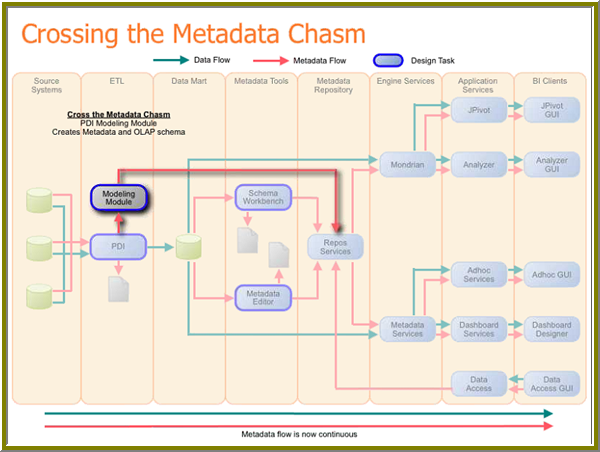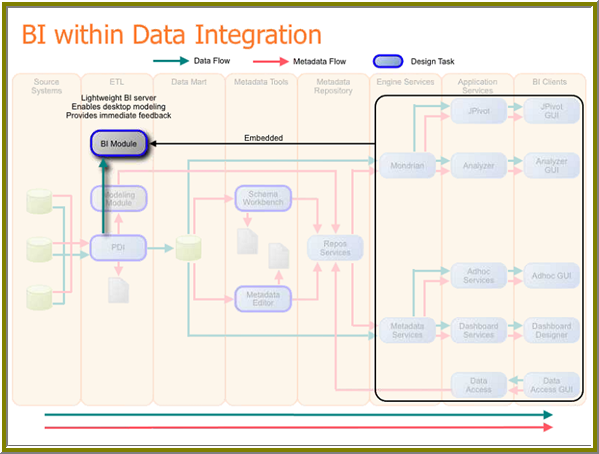An Introduction to Pentaho Agile BI
Important: This document is a collection of notes. It is a rough draft and therefore will undergo many changes prior to being published. The Agile BI project is in early development phase. The UI screenshots included in this document do not reflect the final look and feel of the product.
Pentaho Agile Business Intelligence, (from now on referred to as Agile BI), provides you with a set of tools that allows effective collaboration on BI project prototyping by members of an agile team. That team may be composed of ETL designers, business analysts, database administrators, IT developers, consultants, savvy technical users and more.
Pentaho Agile BI tools enable project teams to work quickly through BI project iterations, allows them to use wider skill sets, enables them to work effectively as a small team, and most importantly, allows them to work cost-effectively.
At its core, the Pentaho Agile BI, offers you an integrated solution that allows you and your team to move seamlessly from ETL to modeling, from data exploration to reporting. Competitor solutions require these steps to occur separately through the use of individual tools and shown below:
Build data warehouse -> Massage the data using ETL tools -> Model the data using modeling tools -> Report and/or analyze data using reporting/analyzing tools
Using Pentaho Agile BI, the process above is integrated into one tool. Leveraging the power of Pentaho Data Integration (PDI), an ETL designer is able to massage data as needed, and, based on input from a business analyst, is able to go directly into visualizing and modeling the data, and finally to providing the data to users for self-serve reporting and analysis purposes. Because the ETL,visualizing, modeling, and reporting tools are integrated, it is easy for ETL designers and business analysts to work iteratively and to make needed changes to the data quickly and effectively. This allows BI projects to run smoothly and cost effectively. Agile BI also allows the ETL designer to add modeling to his or her skill set thus reducing time allotted for proof-of-concept and prototype iterations. So, the process is more like the one described below:
While building a data warehouse, the ETL designer can immediately create a model based on data he or she has already built. The ETL designer can explore (visualize) the data. For example, in cooperation with a BI analyst, the ETL designer may determine, (using visualization provided by Pentaho Analyzer), that certain dimensions are not applicable or that more hierarchies are required. The visualization step also allows data quality issues to be identified and corrected. At this point the ETL designer can return to Pentaho Data Integration and build additional hierarchies, visualize, then model the data again. Adjustments can be made iteratively until the data is exactly what the BI analyst and end users want to see.
Proposed Architecture
In the proposed architecture, Pentaho Data Integration will include a Modeling Module that generates the metadata necessary for Mondrian (Pentaho Analysis) and the metadata services. Pentaho Schema Workbench and the Pentaho Metadata Editor are bypassed allowing the ETL designer to go directly from PDI to the BI Server.
A BI Model that will be embedded into Pentaho Data Integration is actually a trimmed down BI Server that allows the ETL designer, database administrator, or IT developer to perform data visualizations on the fly (locally, on the desktop or laptop) without having to publish the metadata to a BI Server; it also allows for quick end-to-end iterations without requiring a full BI Server installation.
Knowledge Prerequisites
To understand Pentaho Agile BI, you must...
Preliminary User Interface
User Interface, Step 1 -- Data source
User Interface, Step 2 -- Preview the data
User interface, Step 3 -- Transform the data
User Interface, Step 4 -- Start data visualization
User Interface, Step 5 -- Organize data according to the needs of your users
User Interface, Step 6 -- Identify data quality issues
User Interface, Step 7 -- Correct data quality issues
User Interface, Step 8 -- Verify corrected data quality issues
At this point, the ETL Designer can continue to add PDI steps that fine tune the dataset users want to see
User Interface, Step 9 -- Begin modeling










